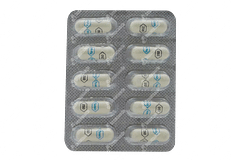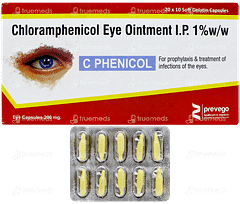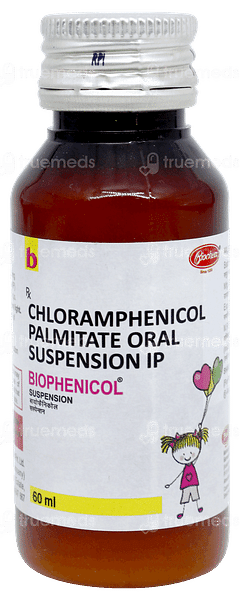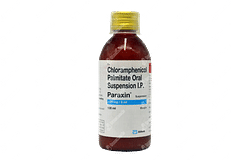Chloramphenicol
Uses of Chloramphenicol
The primary use of Chloramphenicol is for the management of serious bacterial infections, particularly when other antibiotics are ineffective or cannot be used. It falls under the category of broad-spectrum antibiotic medicines.
Alongside its main use, it is also employed for managing severe infections like meningitis, brain abscesses, endocarditis, typhoid fever, eye infections like bacterial conjunctivitis, respiratory tract infections like pneumonia, genital tract, skin and soft tissue infections, and blood infections (septicemia).
Side effects of Chloramphenicol
Nausea and vomiting
Headache
Diarrhoea
Rash or hives
Glossitis or stomatitis
How Chloramphenicol works
Chloramphenicol is a broad-spectrum antibiotic.
It functions by inhibiting the synthesis of proteins in bacteria. This is achieved by binding to the 50S subunit of the bacterial ribosome and blocking the action of peptidyltransferase, an enzyme that creates peptide bonds between amino acids during protein formation. By preventing the addition of new amino acids to the growing peptide chain, Chloramphenicol halts bacteria from creating essential proteins required for their growth and replication. This bacteriostatic action allows your body's immune system to effectively clear the infection.
Certified content
Written By

Bachelor of Dental Surgery
Reviewed By

Doctor of Medicine
Expert Advice
Dosage Forms Available
Chloramphenicol can be taken orally (capsules or oral suspension), intravenously (injection) and applied topically (eye drops, skin ointment or eye ointment).
Age and Dose Restrictions
Chloramphenicol can be used in adults and children of all ages.
Contraindications
Chloramphenicol is contraindicated in patients with known hypersensitivity to it or any component of the formulation and it should not be used in patients with porphyria or pre-existing blood dyscrasias.
Other Medications to Avoid
Chloramphenicol may interact with anticoagulants (such as warfarin, heparin), antidiabetic agents (like tolbutamide and chlorpropamide), anti-epileptic medicines (like phenytoin, phenobarbital), and immunosuppressants (like cyclosporin, tacrolimus).
Overdose and Missed Dose
Overdosing on Chloramphenicol can lead to serious complications such as bone marrow suppression, causing anaemia and other blood disorders. If you suspect an overdose, contact your doctor immediately.
If you miss a dose of this medicine, take it as soon as you remember. However, if it is close to your next dose, skip the missed dose and continue with your regular schedule.
Management of Side Effects
Most side effects are temporary and generally harmless and resolve after discontinuing this medicine. However, if you experience any severe side effects or worsening of any of the symptoms, please consult your doctor.
In case of nausea or vomiting, try taking the medicine with meals.
For headaches, ensure adequate hydration and rest.
If rashes or allergic reactions occur, discontinue the medicine and consult your doctor immediately.
Use in Driving and Operating Machinery
Chloramphenicol may cause dizziness or confusion in some patients. Thus, it is advisable not to drive or operate heavy machinery after taking this medicine unless you are sure how it affects you.
Use in Pregnancy and Lactation
It is advised to consult your doctor before using Chloramphenicol during pregnancy and breastfeeding due to potential risks to the baby.
Caution in Other Conditions
Patients with liver or kidney disease should use Chloramphenicol with caution as dose adjustment may be needed.
Similarly, those with blood disorders should exercise caution due to the risk of bone marrow suppression.
Special Dietary and Lifestyle Recommendations
Maintaining good personal and environmental hygiene might help prevent bacterial infections that require antibiotics like Chloramphenicol.
Adequate rest and hydration are important when fighting off an infection.
Regular health checks can help in the early detection of infections, potentially reducing the need for stronger antibiotics.
Frequently asked questions
Is Chloramphenicol a type of steroid?
No, Chloramphenicol is not a steroid. It is a broad-spectrum antibiotic medicine used to manage severe bacterial infections.
Does Chloramphenicol have any effect on sleep?
Chloramphenicol is not directly associated with affecting sleep. However, some side effects such as headaches may indirectly affect sleep quality.
Will Chloramphenicol affect fertility?
Chloramphenicol is not directly associated with affecting fertility in men or women. However, given its severe side effects, it is recommended to consult a doctor before use.
Is it safe to take Chloramphenicol daily?
Chloramphenicol should be taken strictly as recommended by your doctor. It is typically prescribed for severe, life-threatening infections when other medicines are ineffective.
How much time does Chloramphenicol take to work?
The time taken for Chloramphenicol to show its effect can vary depending on the severity and type of infection. It should be used as per the doctor's prescription.
Is Chloramphenicol available over the counter, or do I need a prescription?
Chloramphenicol usually requires a doctor's prescription and is not readily available over the counter due to its potential serious side effects.
Are there any natural alternatives to Chloramphenicol?
While there may be natural substances with antibacterial properties, they should not be used as a substitute for prescribed antibiotics like Chloramphenicol without discussing it first with your doctor.
Chloramphenicol in other salts
List of Medicines for Chloramphenicol








Company
About UsHealth ArticleHealth StoriesHealth LibraryDiseases & Health ConditionsAyurvedaUnderstanding Generic MedicinesAll MedicinesAll BrandsNeed HelpFAQSecuritySubscribe
Registered Office Address
Grievance Officer
Download Truemeds
Contact Us
Our customer representative team is available 7 days a week from 9 am - 9 pm.
v4.10.3
2025 - Truemeds | All rights reserved. Our content is for informational purposes only. See additional information.
Our Payment Partners










